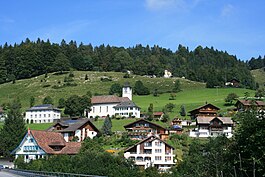Innerthal
| Innerthal | ||
|---|---|---|
 |
||
|
||
| Coordinates: 47°6′N 8°55′E / 47.100°N 8.917°ECoordinates: 47°6′N 8°55′E / 47.100°N 8.917°E | ||
| Country | Switzerland | |
| Canton | Schwyz | |
| District | March | |
| Area | ||
| • Total | 50.16 km2 (19.37 sq mi) | |
| Elevation | 915 m (3,002 ft) | |
| Population (Dec 2015) | ||
| • Total | 193 | |
| • Density | 3.8/km2 (10.0/sq mi) | |
| Postal code | 8858 | |
| SFOS number | 1343 | |
| Localities | Wägitalersee | |
| Surrounded by | Einsiedeln, Glarus (GL), Muotathal, Näfels (GL), Oberurnen (GL), Schübelbach, Unteriberg, Vorderthal | |
| Website |
www SFSO statistics |
|
Innerthal is a municipality in March District in the canton of Schwyz in Switzerland.
Innerthal is first mentioned in 1259 as Wegental. Until 1888 it was known as Hinterwäggithal.
As of 2006[update] Innerthal has an area of 50.2 km2 (19.4 sq mi). Of this area, 34.9% is used for agricultural purposes, while 34.1% is forested. Of the rest of the land, 0.4% is settled (buildings or roads) and the remainder (30.6%) is non-productive (rivers, glaciers or mountains).
The municipality is located on Wägitalersee, a reservoir in the upper Wägital.
Innerthal has a population (as of 31 December 2015) of 193. As of 2007[update], 2.1% of the population was made up of foreign nationals. Over the last 10 years the population has grown at a rate of 5%. Most of the population (as of 2000[update]) speaks German (97.0%), with Italian being second most common ( 1.8%) and Rhaeto-romance being third ( 0.6%).
As of 2000[update] the gender distribution of the population was 48.5% male and 51.5% female. The age distribution, as of 2008[update], in Innerthal is; 46 people or 27.5% of the population is between 0 and 19. 44 people or 26.3% are 20 to 39, and 56 people or 33.5% are 40 to 64. The senior population distribution is 15 people or 9.0% are 65 to 74. There are 6 people or 3.6% who are 70 to 79 and no one is over 80.
As of 2000[update] there are 64 households, of which 13 households (or about 20.3%) contain only a single individual. 5 or about 7.8% are large households, with at least five members.
...
Wikipedia




